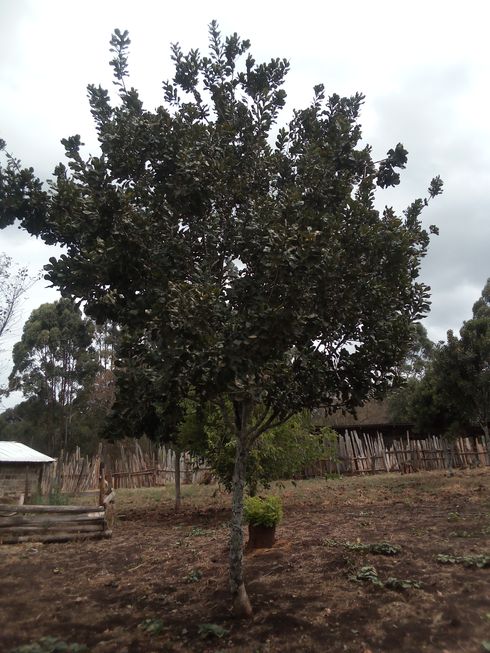My farming journey into macadamia nut growing began with my mother. She thought it would be a good idea for us to broaden our income source. Once we agreed, we got the tree seedlings from our agricultural research institute KARI(Kenya Agricultural Research Institute) then but now known as KALRO(Kenya Agricultural and Livestock Research Organization). It is while we were here that we were told that they have two varieties of macadamia tree. one One produces smooth nuts while the other rough. We decided to try each. We bought half and half. We got 70 seedlings.

A macadamia tree
Growing the macadamia trees from nuts is possible, but it takes at least 8 years for the tree to start producing any fruit. Also the yield may be little as it inherently passes on the genes that affect production(heterozygous). Grafting is the preferred method of propagation as you can select the best qualities.
Once the site was selected, we dug holes at least 7 metres apart and about 60 cm deep. We then added a handful of well dried composted farm yard manure. It is also recommended to add a compound fertilizer like DAP or NPK and incorporate well in the soil. When planting, always ensure that the seedling is covered up to the level where the stem was covered in the seedling bag. This is so as to avoid burying the graft union.
Watering is important and should be done regularly. This step can be skipped if you do the transplanting during the rainy season. The planting site should be in an area with good drainage. Water logging as well as lack of water cause stress to the plant and should be avoided. Mulching is important as it will conserve water especially in the dry season.
The macadamia seedlings should be weeded for regularly. This reduces competition for nutrients, water and sunshine for optimal growth. Staking should also be done when transplanting. This prevents lodging.
As the macadamia seedling grows, it should be pruned and trained. The purpose of this is to produce strong well balanced branches on one trunk. If pruning and training is not done within the first three years, the tree will form unevenly spaced and weak branches on the trunk. These will be problematic as they usually break when strong wind is blowing. For us, two trees have had wind damage as the pruning and training was not done early enough.
De-suckering is also done to macadamia trees until they are one meter in height. This is done because the suckers prevent the vertical growth of the tree.
There are some pests and diseases that affect the macadamia tree. The best way to manage them is by scouting regularly to catch them out early. There are fungal disease like blight and root rot that can be prevented by having a preventative spray regime. The same can be done for the pests like the macadamia stink bug, nut borers, weevils and thrips.
Pollination of the macadamia is done by insects. Bees and other beneficial insect are required. A single macadamia tree flower will require about 150 visits for proper pollination.
Our macadamia farming journey started off well and the seedlings were transplanted. The problems started arising during the weeding phase. The workers who were sent to do the work either through malice or ignorance, destroyed over 60 of the planted trees.
The 5 trees that survived were all around the homestead. They produce about 20 kilos of macadamia nuts per harvest. After the nuts fall off the tree, they are collected, dehusked and dried in a solar drier for about a week. Up to this point most of the produce is mostly for own consumption with the surplus given to friends and family. We have however, began to actively look for a buyer for the nuts as an additional source of income.
The trees are expected to continue increasing their production of macadamia nuts up to the 15th year. By this time each tree should be producing between 40 – 75 kgs of nuts per season.
Would I do it again?
I think fruit and nut tree growing is a profitable venture when done properly. This is especially true for macadamia nuts. If the 70 macadamia trees had survived, we would be looking at a potential harvest of 2.8 – 5.4 tonnes of macadamia nuts per season. With a price of about $1.75 - 2 per kilo that would have been a cool supplemental income.
Not that everything is smooth sailing in the macadamia nut sector in Kenya. I realise that there are problems with middlemen who cheat farmers out of their toil for production. They had been offering as low as ¢30 per kilo to farmers, but then selling to processors and exporters for more than double. The government regulation and support policies also need to be enhanced, as part of the problems stem from reactive rather than preventative measures.
The reason we are not adding macadamia trees in addition to the government stance, is the diversification into other fruit trees, namely avocado and bananas.